A reported 98 percent of marketers say attribution is crucial to their marketing efforts, but over 70 percent fall short of their strategic goals. That gap doesn’t just show up in spreadsheets, it leads to unfair payouts, frustrated creators, and partnerships that never reach their potential.
All of this is happening while the creator economy itself is thriving. What was a $1.4 billion space in 2014 has grown into a $32 billion industry in 2025. Yet most brands are still stuck with last-click attribution, a model built for a simpler time. It captures only the final step of a purchase journey and ignores the creators who sparked the discovery or built the trust that actually made the sale possible.
While there are constant shifts in the creator economy, attribution models need to evolve along with it. Jeff Melton, Sr. Director of Global Creator Community & Consulting at impact.com, adds that the traditional methods brands use to compensate creators are becoming unsustainable for the future.
The solution is to use attribution models that reflect how people shop today. These models take into account multiple platforms, touchpoints, and the role of creators at every stage. They distribute credit more accurately, highlighting how creators drive awareness, influence, and ultimately conversions.
The payoff is better return on investment (ROI) measurement, fairer compensation, and stronger partnerships.
In this blog:
- Explore various attribution models and their role in creator marketing.
- Understand how they apply to unique customer journeys.
- Learn how to choose the best model for your brand’s campaigns and compensation strategy.
What are attribution models? A foundation for creator program success
Attribution models are frameworks that assign credit to marketing touchpoints leading to a conversion event. Think of them as scorekeepers for your marketing efforts. For brands running creator programs, these models determine how much credit each creator interaction receives when someone makes a purchase.
Traditional marketing attribution was simple. Email, paid search, display ads—the customer journey felt refreshingly linear. Someone searched, clicked an ad, and purchased. Credit assignment was straightforward.
Until creator marketing blew up that playbook.

Why creator marketing demands a new attribution approach
Nearly a third of consumers buy from brands they found on social media, and oftentimes it’s the creators driving those conversions. The path to purchase now weaves through multiple creator touchpoints across different platforms, formats, and timeframes.
Here’s how the journey may look today:
- One creator sparks awareness in a short TikTok video
- A second creator builds trust through an in-depth YouTube review
- The third creator closes the deal via Instagram Stories with a discount code
The creator economy is reshaping affiliate marketing, requiring new attribution models. These models need to:
- Track creators’ influence on awareness, consideration, and purchases
- Ensure fair compensation based on real impact
- Move beyond outdated, incomplete measurement methods
It’s time to capture the full story.
The stakes couldn’t be higher. Only 29 percent of marketers consider themselves successful in using attribution to achieve strategic objectives. The remaining 71 percent need to improve their marketing attribution programs to unlock the true value of their creator partnerships.
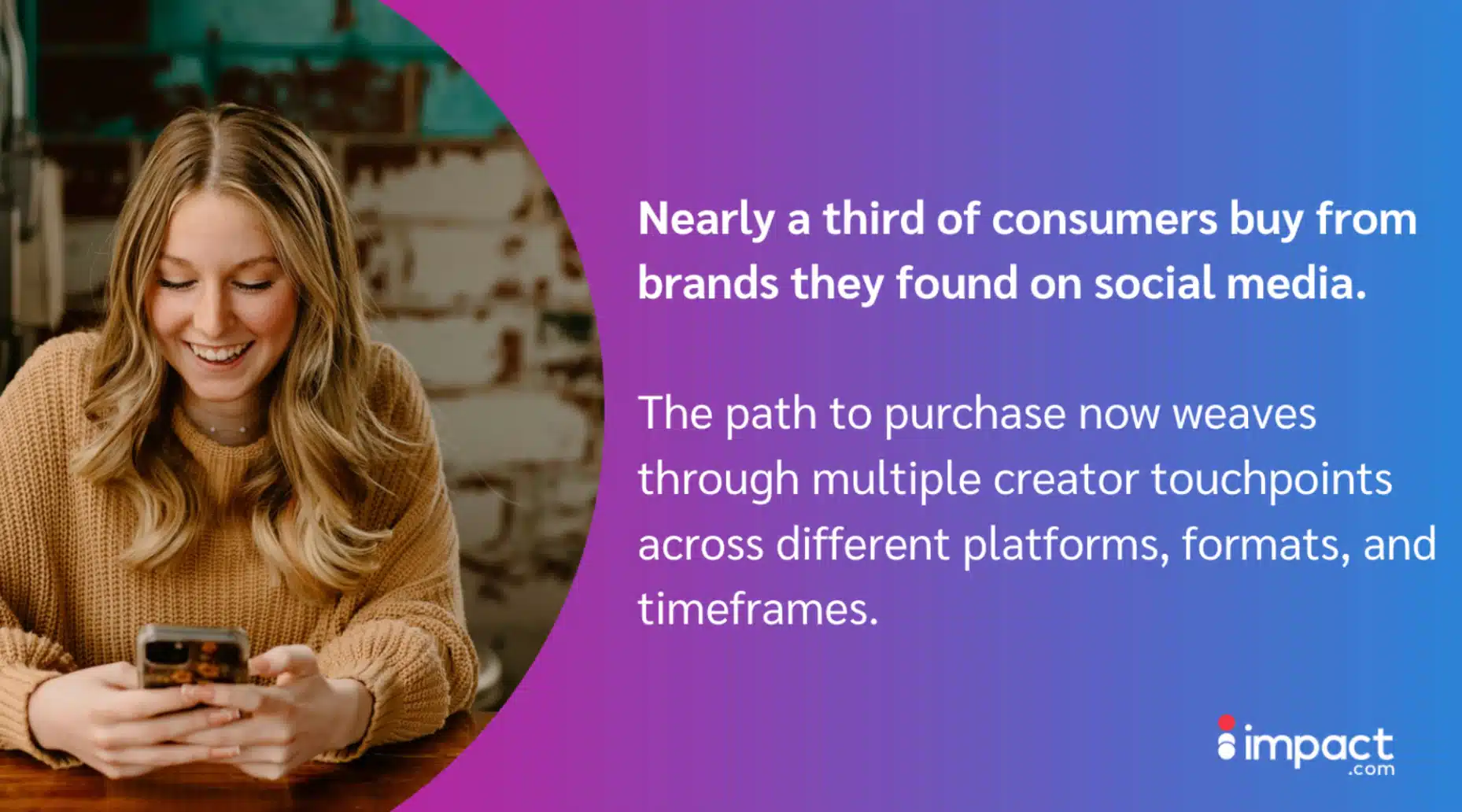
The unique challenge of creator marketing attribution for brands
Content creators today often act as affiliates in the customer journey—adding to the complexity of attribution.
Each touchpoint plays a part, but last-click attribution only credits the final interaction. This creates a measurement problem that affects both strategy and compensation.
Lacie Thompson, SVP of Growth, Affiliate at New Engen, breaks down the fundamental problem of last-click attribution, revealing, “Creator content isn’t as clickable as other partnerships. If you rely only on click-based attribution—especially last-click, common in the affiliate channel—you likely won’t believe that it works most of the time.”
The complexity runs even deeper. Creator marketing spans multiple platforms, each with different user behaviors and conversion patterns. Traditional attribution models overlook these interconnected touchpoints entirely.
Single-touch attribution models: simple, but often incomplete
Single-touch attribution assigns 100 percent of the credit to a single touchpoint. It’s easy to set up, easy to explain, and has been a staple in marketing measurement for years.
Limitations: The downside is that simplicity comes at a cost. These models usually fail to capture the layered influence creators have across awareness, consideration, and conversion. That blind spot can damage creator relationships and lead to skewed budget decisions.
Single-touch attribution models can be divided into two approaches:
- First touch attribution models
- Last-touch attribution models
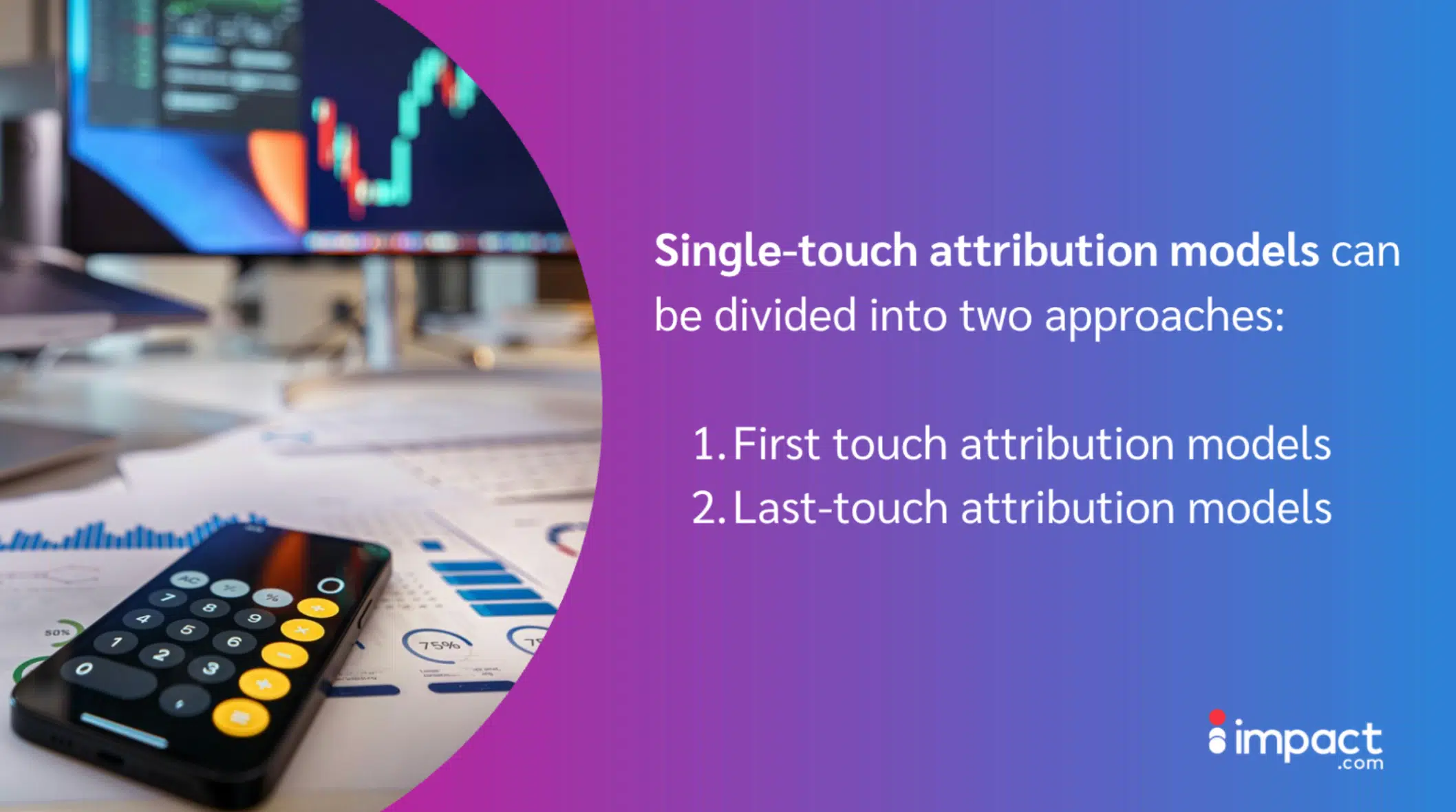
1. First-touch attribution model: credits the first interaction in the customer journey
First-touch attribution gives all credit to the initial brand interaction. For creator programs focused on brand awareness and discovery, this model captures value that other approaches ignore.
Strength: It’s a strong fit for launches and market entry. The creator who introduces your brand to their audience gets full recognition for conversions that follow, no matter how many steps occur afterward.
Weakness: The challenge is that customer journeys are rarely this simple. A creator might spark initial interest, but other touchpoints, often including more creator content, shape the final purchase decision. By ignoring those later influences, the model creates a distorted view of performance.
When to use this model: First-touch attribution works best for campaigns where discovery is the main goal. For complex products with longer decision cycles, multi-touch models provide a more accurate read. The same applies when multiple creators guide the same audience.
2. Last-touch attribution model: credits the final interaction before a conversion event
Last-touch attribution credits the final touchpoint before someone converts. It’s a familiar method in performance marketing because it makes conversion tracking simple and easy to explain.
Strength: For brands focused on direct response and quick ROI, the appeal is obvious: the creator who drives the last click gets full compensation, and accountability is crystal clear.
Weakness: From a creator’s perspective, this model falls short. Natasha Skolnick, Global Director of Partnership and Influencer Marketing at Vistaprint, notes that creators invest heavily in content that shapes awareness and consideration, yet the last-touch model ignores their contribution. “They’re not getting enough credit, so it’s not worth it for them,” she explains.
The result is a system that undervalues early-stage influence and leaves many creators frustrated enough to walk away from programs altogether.
When to use this model: Last-touch attribution works best for direct response campaigns with short purchase paths. For brand building and complex products, a multi-touch model offers a more accurate picture of performance.
Multi-touch attribution models: capturing the full creator customer journey
Multi-touch attribution gives a realistic view of how creator content works together to drive results. Unlike traditional single-touch models, it spreads credit across multiple touchpoints in the conversion path.
This approach is essential: up to 80 percent of influencer-driven purchases happen in untraceable journeys. Multi-touch models capture this hidden value that would otherwise go untracked and unbudgeted.
Multi-touch attribution models come in various forms:
- Linear attribution model
- Time decay attribution model
- U-shaped (position-based) attribution model
- W-shaped attribution model
- Data-driven attribution model
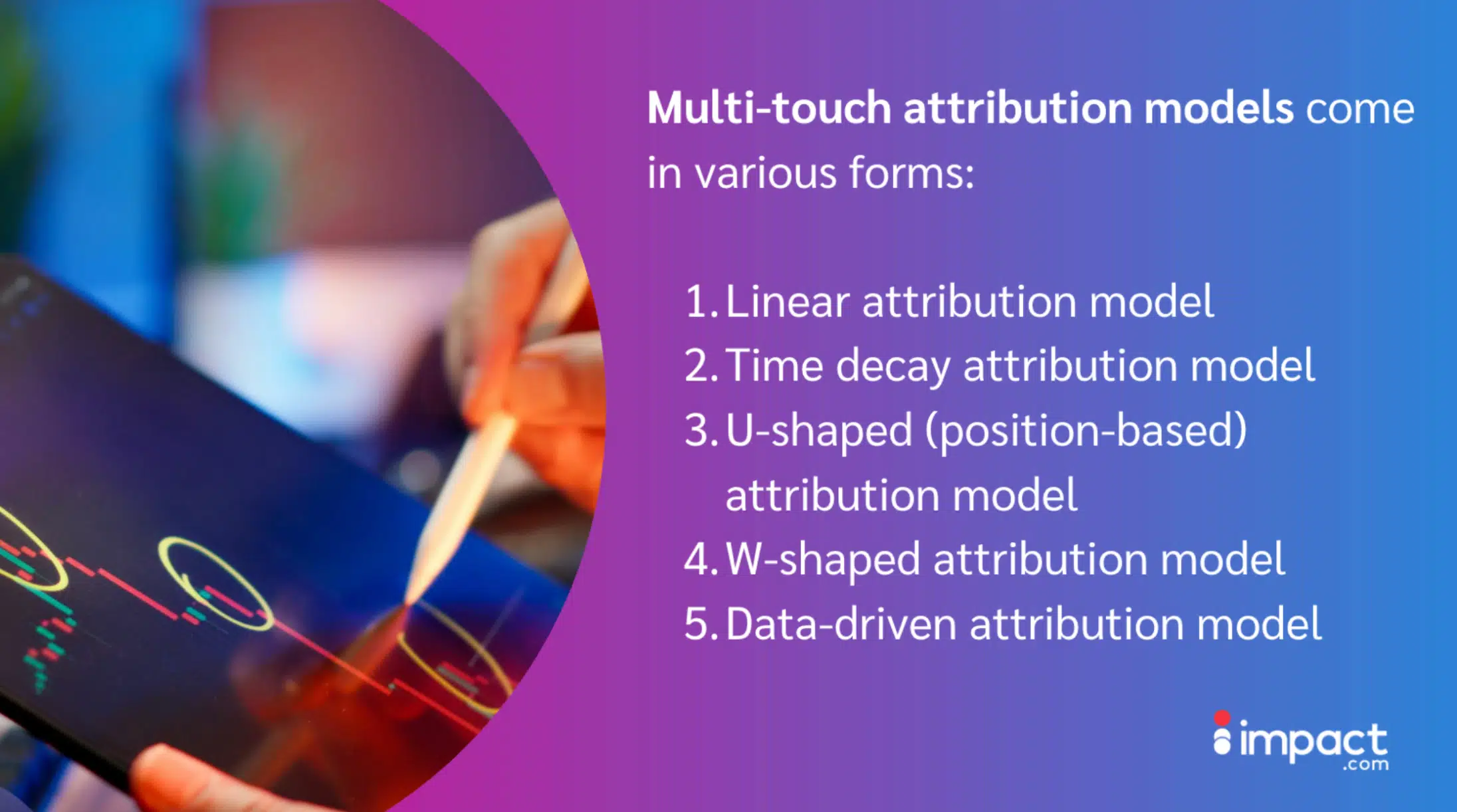
Adapting to industry shifts: why multi-touch attribution is essential now
The metrics for measuring a creator’s impact are still evolving. As a result, brands must adapt to these industry shifts. Those stuck in a last-click mindset risk falling behind the competition.
Competitive advantage
Early adopters who embrace multi-touch models gain significant advantages through:
- Fair compensation
- Stronger partnerships
- A clearer understanding of their ROI
Cost of inaction
While the competitive advantage is high, the inverse is true for the cost of inaction:
- Unfair compensation
- Frustrated creators
- Wasted budgets
Industry analyst Jasmine Enberg makes the case directly, adding, “You can’t rely on last-click attribution to measure the full impact of influencer marketing”. Multi-touch models strengthen creator partnerships by supporting fairer compensation and recognizing each contributor’s role in the customer journey. They also encourage long-term collaboration and reduce churn.
1. Linear attribution model: equal credit to all marketing touchpoints
Linear attribution divides credit evenly across every touchpoint in the path. If four creator interactions lead to a purchase, each gets 25 percent.
Strength: The benefit is simplicity. It’s easy to explain, easy to run, and ensures all creators get some credit. This makes it a good entry point for brands new to multi-touch attribution or those without deep analytics capabilities.
Weakness: The model’s weakness is oversimplification. Not all touchpoints have equal influence on purchase decisions. A detailed YouTube product review could have more impact than a brief Instagram Story mention, but linear attribution treats them the same.
When to use this model: Use linear attribution as a starting point for multi-touch measurement, especially when transitioning from single-touch models. Plan to evolve toward more sophisticated approaches as your data capabilities improve.
2. Time decay attribution model: more credit to marketing touchpoints closer to conversion
Time decay attribution gives more weight to recent touchpoints while still recognizing earlier influences. The closer the interaction is to the purchase, the more credit it earns.
Strength: This balances early-stage awareness with late-stage conversion drivers. For example, a creator who sparks initial interest gets partial credit, but the one delivering the final product demo gets more.
Weakness: This model may place too much importance on the final steps when the customer journey is brief.
When to use this model: Time decay works best for products with defined consideration phases. It captures how influence shifts over time while keeping the model straightforward to implement.
3. U-shaped (position-based) attribution model: more credit to first and last touch
U-shaped attribution assigns 40 percent of credit each to the first and last touchpoints, with the remaining 20 percent spread across the middle.
Strength: This model prioritizes discovery and conversion.
Influencers typically drive 80-90 percent of new traffic, according to Thompson. This is invaluable for brands, as she explains, “You have to be thoughtful about how you compensate your partners when that’s the reality.”
Weakness: Mid-funnel touchpoints are often overlooked and undervalued.
When to use this model: This model values the creators who open the door and those who close the sale, while still giving middle-funnel contributors their share. It’s especially effective for campaigns with dual goals of awareness and conversion.
4. W-shaped attribution model: credit to first touch, lead creation, and last touch
W-shaped attribution credits three key milestones:
- First touch: 30 percent
- Lead creation: 30 percent
- Last touch: 30 percent
The remaining 10 percent is spread across other interactions.
Strength: This model recognizes three critical milestones in the customer journey.
Weakness: The catch is complexity. W-shaped attribution requires precise lead tracking and cross-channel attribution, making it best for brands with more advanced data infrastructure.
When to use this model: This model is particularly suited for B2B or high-consideration products where lead generation is a crucial step. It ensures that creators driving awareness, lead capture, and final conversion all receive meaningful credit.
5. Data-driven attribution model: the future of creator marketing attribution
Data-driven attribution uses machine learning to assign credit based on actual customer paths. Instead of relying on fixed rules, it studies historical data to determine the real influence of each touchpoint.
This makes it the most accurate approach available today. Algorithms spot patterns that human analysts miss, factoring in both direct creator influence and outside variables.
Marketers are making the case for data-driven attribution models:
- 50 percent say it improved their ROI
- 70 percent believe it’s more accurate than traditional models
Strength: Because the model adapts to your brand’s unique journey, it reflects reality. If Instagram Stories consistently outperform TikTok in driving conversions, the model adjusts credit automatically. This precision allows for smarter budget allocation and fairer compensation.
Platforms like Google Analytics 4 offer data-driven attribution, but specialized creator marketing tools often go deeper and provide more granular insights tailored to partnership programs.
Weakness: This model requires large, integrated datasets.
When to use this model: Mature programs with advanced analytics.
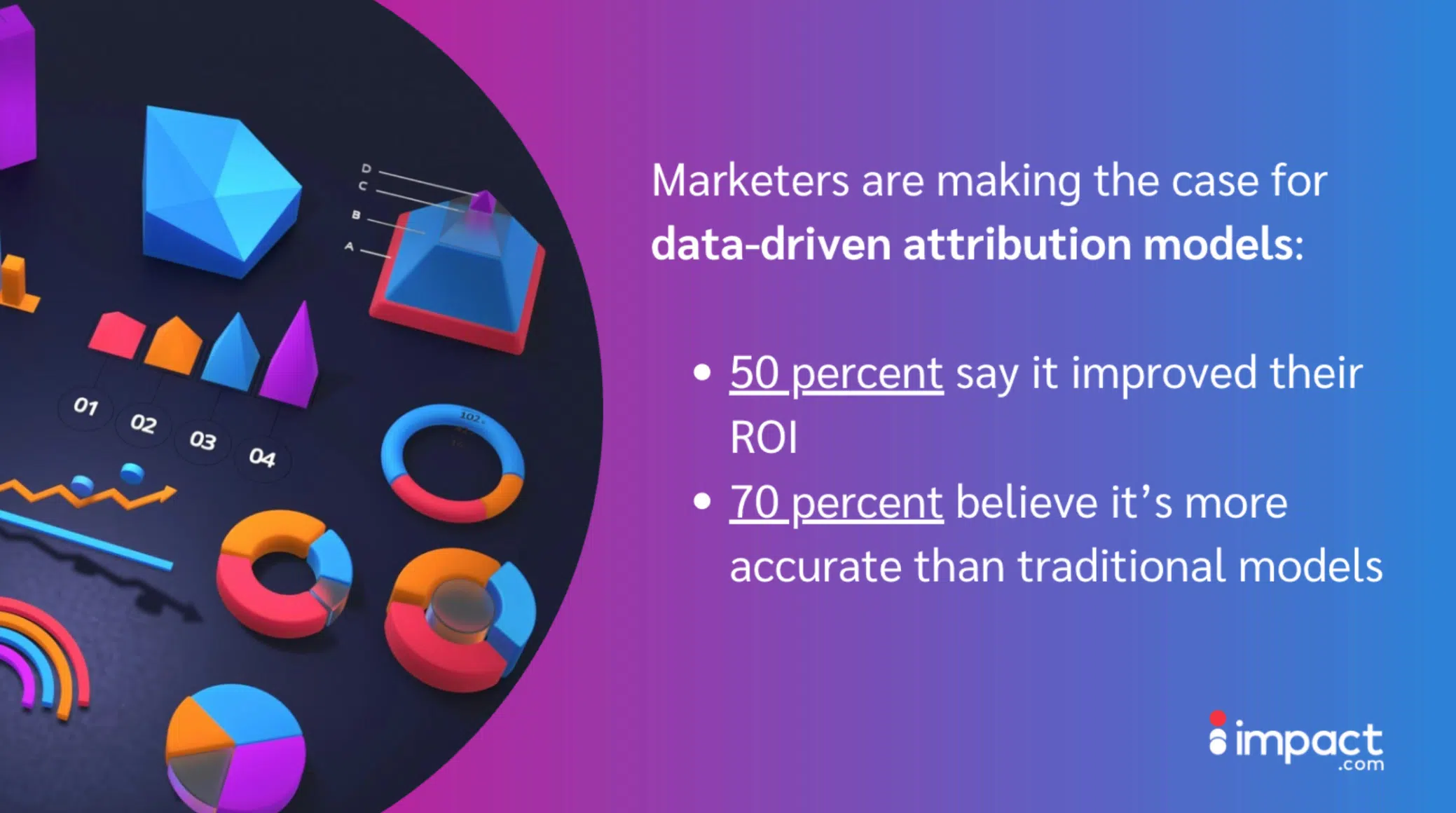
| How to choose the right attribution model: a quick comparison | |||
| Model | Strength | Weaknesses | Best use case |
| First-touch | Captures discovery value | Ignores mid- and late-funnel influence | Awareness campaigns, launches, market entry |
| Last-touch | Easy to implement; fair recognition across creators | Undervalues early-stage creators; discourages participation | Short direct-response campaigns |
| Linear | Balances early vs late-stage contributions | Oversimplifies differences in impact | Entry-level multi-touch programs |
| Time decay | Balances early vs late-stage contributions | May overvalue last steps if journey is short | Products with defined consideration phases |
| U-shaped | Prioritizes discovery and conversion | Middle touchpoints undervalued | Programs balancing awareness + conversion goals |
| W-shaped | Recognizes three critical milestones | Requires large, integrated datasets | B2B or complex products with lead gen |
| Data-driven | Most accurate; adapts to real customer paths | Requires large, integrated datasets | Mature programs with advanced analytics |
Choosing the best creator marketing attribution model to maximize ROI
Selecting an attribution model means matching your measurement approach to program goals, customer journey complexity, and available data. There’s no universal formula, the best model depends on your brand’s specific context.
Start by mapping the customer journey:
- How many creator touchpoints usually precede conversion?
- Which types of content tend to drive awareness vs conversion?
These answers point you toward the model that fits your needs.
Weigh program maturity: New creator programs may need simpler setups such as linear or time decay attribution. As data grows and analysis tools improve, you can move toward data-driven approaches that capture the full picture.
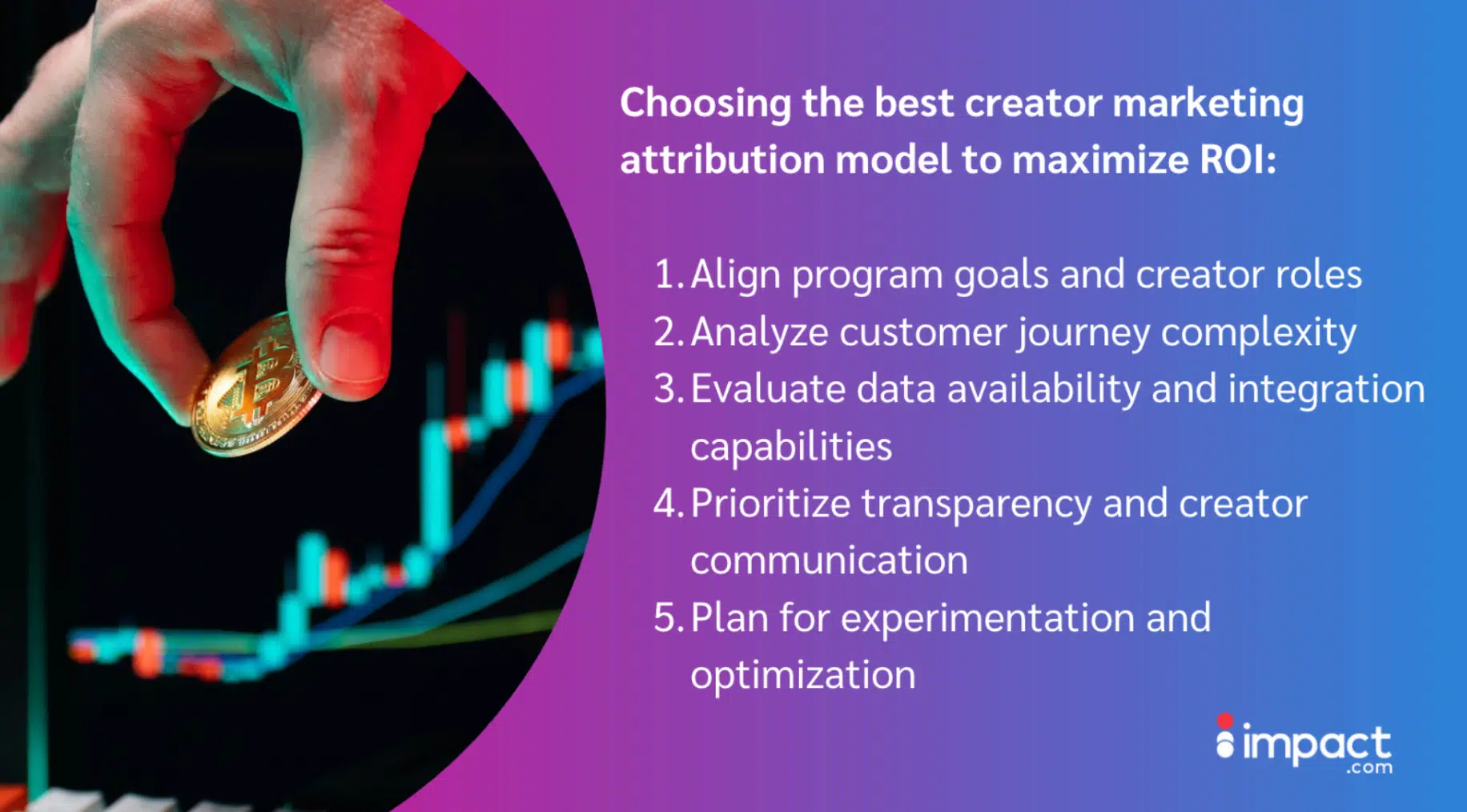
Step 1: Align program goals and creator roles
Attribution models should reflect campaign objectives and the roles creators play:
- For brand awareness campaigns: First-touch attribution captures the value of discovery-focused creators
- For lead-generation programs: W-shaped attribution recognizes multiple stages creators influence throughout the funnel
- For direct response campaigns: Last-touch attribution provides clear accountability (use sparingly)
Step 2: Analyze customer journey complexity
Your attribution model should adapt to the following dynamics for accurate insights.
Simple vs complex products
- Simple products with short consideration periods: Use single-touch attribution models.
- Complex products with longer journeys: Requires multi-touch attribution.
Key steps for attribution
- Map the number of creator interactions before conversion.
- Analyze the timeframe for these interactions.
Consider seasonality
- Holiday shopping: Compresses purchase journeys.
- B2B decisions: Tend to have longer timelines.
Step 3: Evaluate data availability and integration capabilities
Your attribution accuracy depends entirely on data quality and integration across marketing channels:
- Single-touch models: Require basic conversion tracking
- Multi-touch models: Need comprehensive customer journey data across all creator touchpoints
- Data-driven attribution: Demands substantial historical data and advanced analytics capabilities
Integration also matters. Your attribution model should pull from all relevant sources to reflect the full picture:
- Social platforms
- Affiliate networks
- Conversion systems
Step 4: Prioritize transparency and creator communication
Whatever model you choose, communicate it clearly to creator partners. Transparency builds trust and helps creators understand how their compensation gets calculated.
It’s also important to consider payment terms and understand that creators have bills to pay. As Brianna Doe, Founder and CEO of Verbatim puts it, anything up to 90 days and over is unreasonable: Aim for 30 days and up to 45 if you’re a larger brand like Nike.
Document your attribution approach and share it with partners. Doing so reduces disputes and encourages creators to tailor their content in ways that boost measurable performance.
Step 5: Plan for experimentation and optimization
Attribution models require ongoing calibration. Customer behavior shifts, content formats evolve, and platform algorithms change. Regular testing and refinement keep your model accurate.
Practical optimization tactics:
- Compare different models on similar campaigns
- A/B test linear vs time decay attribution
- Review attribution results quarterly
- Track whether outcomes align with actual creator contributions
The best model should improve decision-making, support fair compensation, and drive stronger performance over time. Choose what fits your current stage, then evolve as your program matures.
Choosing the right model is an important step. But the real challenge and opportunity lie in how you implement attribution across platforms, integrate data, and act on the insights. That’s where advanced attribution practices come in.
Implementing advanced attribution models to optimize performance
Implementation success depends on effective tools, clean data integration, and clear optimization processes. Advanced attribution requires disciplined execution.
The complexity varies by approach. Single-touch models need basic tracking, while data-driven attribution requires full measurement infrastructure and ongoing analysis.
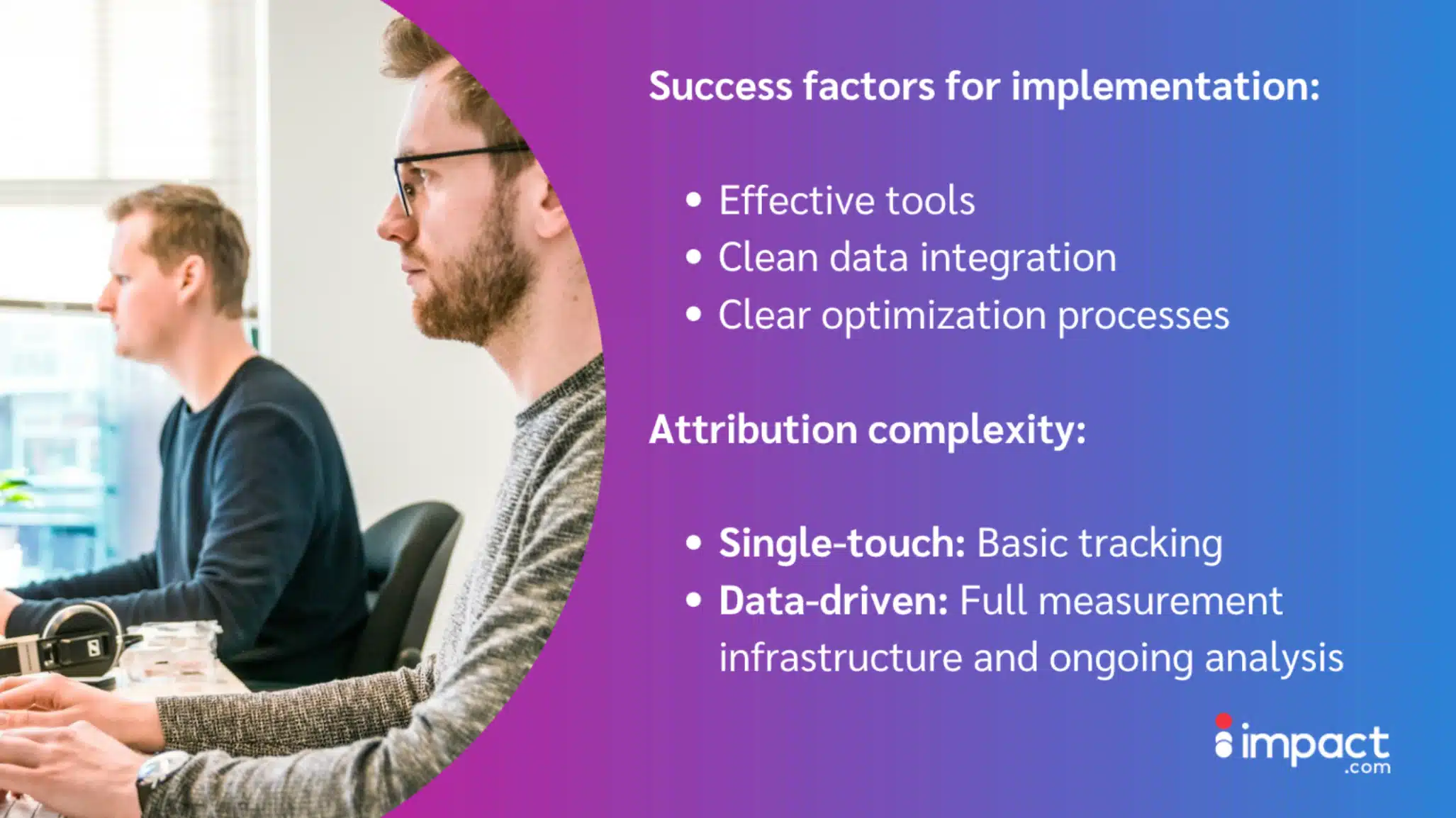
Leveraging tools for granular tracking
Modern attribution requires specialized tools that capture creator performance across every touchpoint. Generic analytics often fail to pick up how creator content shapes decisions, and that’s revenue left unaccounted for.
Core tracking components include:
- Creator partnership platforms like impact.com to monitor performance across social platforms, affiliate links, and direct conversions.
- UTM parameters and unique tracking codes for each creator and campaign.
- CRM systems integrated with attribution tools to connect content exposure to customer outcomes.
- Cross-platform data capture to map complete customer journeys.
With these in place, multi-touch attribution becomes actionable. Without them, even the best model is reduced to guesswork.
Data integration and analysis for comprehensive measurement
Attribution data only works if it connects.
Fragmented inputs create blind spots, while integrated systems give you a full customer journey view. Centralizing data across channels and creators ensures attribution reflects reality.
Dashboards that visualize journeys make attribution insights accessible for both marketing teams and creator partners. Transparency here builds trust and gives creators a reason to optimize their own output.
There also needs to be an element of education for marketing leaders who are used to seeing performance teams come with clear numbers. Skolnick explains this further, “A lot of my role involved continuing to remind and educate about why attribution matters, why having all the content out there matters, and the different ways success is measured.”
Best practices for integration:
- Track external factors like seasonal trends, competitor activity, and market shifts that influence attribution accuracy.
- Set data quality standards and audit regularly.
- Automate reporting to keep attribution data updated in real time.
- Build cross-platform views that capture the full creator ecosystem.
These steps create the backbone for reliable measurement and future optimization.
Optimizing for revenue and creator motivation
Use attribution insights to reallocate budgets toward high-performing creators and content types. Data should drive investment decisions, not gut feelings or whoever has the prettiest Instagram feed.
Refine creator briefs based on attribution learnings. If certain content formats consistently drive conversions, provide creators with examples and guidance to shape their output.
When attribution is fair and transparent, creators see the connection between effort and compensation. That motivates them to invest more in your program, creating a feedback loop where better performance generates better data, and stronger results
How multi-touch attribution models improve ROI measurement
Multi-touch attribution uncovers value that single-touch models overlook. It shows how creators contribute to awareness, consideration, and conversion. This allows for smarter budget allocation. It also ensures fairer compensation and improves program performance.
The benefits compound over time. Better attribution leads to fairer payments, which strengthen creator relationships. Stronger relationships drive better content performance, which generates cleaner data—fueling the next cycle of optimization.
Beyond last-click: capturing full-funnel creator value
Traditional attribution often obsesses over bottom-funnel performance, completely missing the awareness and consideration value creators provide. Multi-touch models capture this complete picture.
Influencer marketing has become a full-funnel strategy, even if it’s mostly top of the funnel. Brittny Kindred, Senior Manager of Affiliate and Influencer Marketing at The Home Depot adds that “there are other call to actions that we can leverage, especially with paid media, and that helps build out that full funnel. It tells leadership the true value of influencer marketing beyond impressions.”
Why this matters for your budget:
- Top-funnel creators who drive brand awareness receive credit for their contributions to eventual conversions
- Middle-funnel creators who nurture consideration and build trust get appropriate attribution
- You stop penalizing awareness-driving creators who don’t get the final click
This recognition supports diverse creator strategies within your program and enables more strategic content planning. No more creators getting shortchanged because they caused interest instead of closing deals.
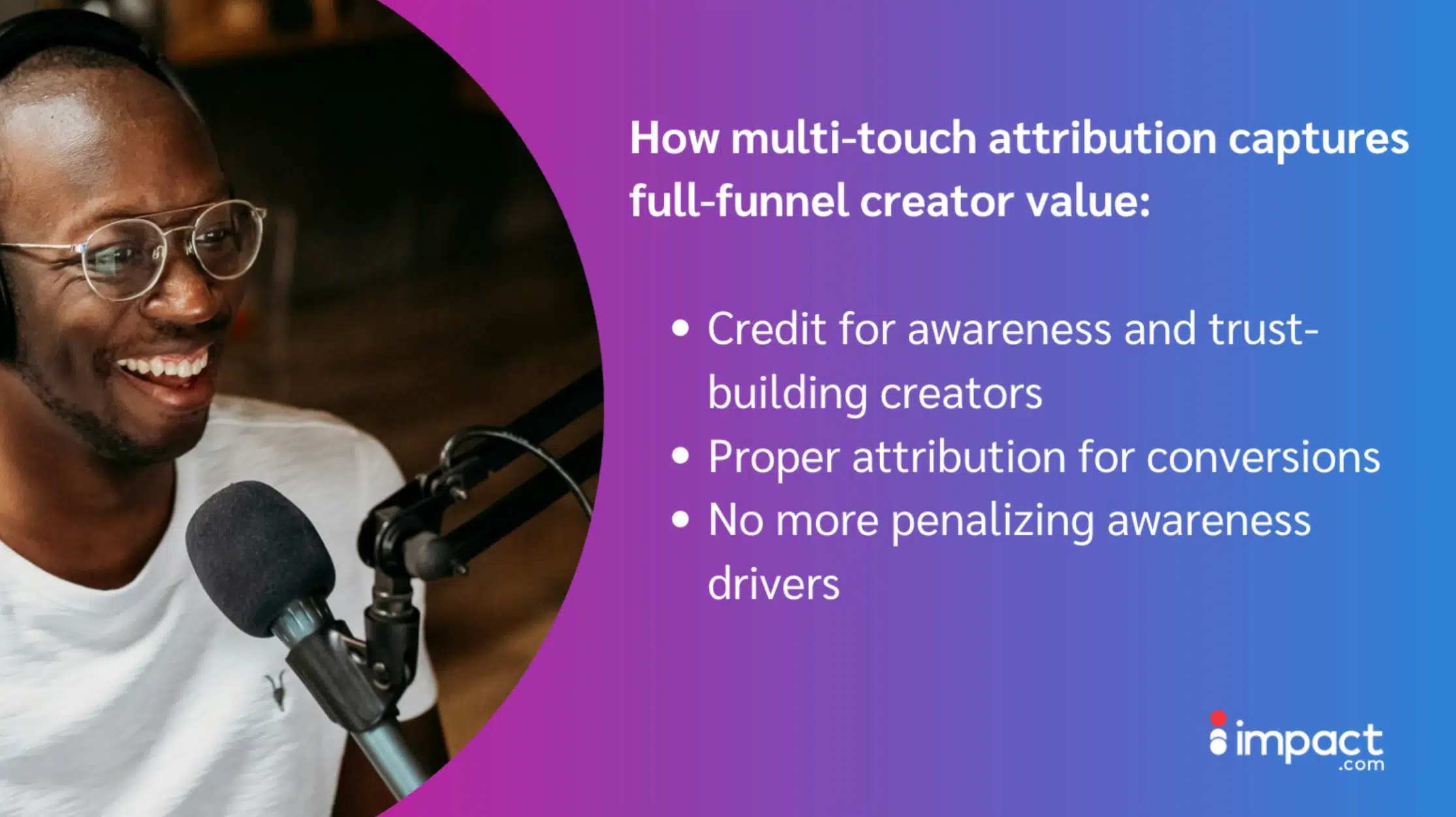
Directs budget allocation with accurate performance data
Multi-touch attribution provides clearer insights into which creators, content types, and platforms actually drive the strongest ROI. This data enables more precise budget allocation decisions—and fewer “why did we spend money on that?” moments.
Here’s how to put these insights to work:
- Identify MVP creators: Find partners who consistently appear in high-value customer journeys and reward them with increased investment and longer-term contracts.
- Decode content performance: Spot formats that perform well at specific journey stages, then prioritize budget toward proven formats while continuing to test new ones.
- Define platform roles: If Instagram drives awareness while YouTube converts sales, shape budgets around these distinct functions instead of treating all platforms the same.
The result is a proof-led budget allocation. Instead of spreading money evenly across all creators and hoping for the best, you’re investing strategically based on proven performance patterns.
Your high-performing creators get the resources they deserve, while underperforming partnerships get optimized or eliminated.
FAQs about marketing attribution models for brands
Attribution models in creator partnerships are frameworks used to assign credit to various creator touchpoints that contribute to a customer’s conversion. They help brands understand which creator content and interactions are most effective in guiding customers through their journey. By applying these models, brands can optimize their strategies and ensure fair compensation across their creator programs.
Historically, last-touch attribution has been the most commonly used model, giving all credit to the final interaction before conversion. However, as creator marketing grows more complex, multi-touch models are gaining prominence. While last-touch is simple to implement, it provides an incomplete picture of how creators influence purchase decisions across longer customer journeys.
impact.com offers comprehensive tracking and reporting features that support sophisticated attribution modeling for creator partnerships. The platform enables granular tracking across marketing touchpoints and conversion events, providing precise data on how creators influence customer journeys. It also manages payment distribution based on various attribution models, ensuring transparent and fair creator compensation.
Accounting for offline creator efforts requires creative tracking approaches. While direct digital tracking is limited, brands can use unique discount codes, specific landing pages, or post-purchase surveys asking “How did you hear about us?” to connect offline creator activity to conversions. Advanced models might also use lift studies or correlational analysis to estimate offline impact.
Brands should review attribution models quarterly or semi-annually. The dynamic creator economy and evolving customer behaviors mean optimal attribution approaches change over time. Regular reviews ensure models remain accurate and support fair creator compensation. More frequent reviews may be necessary during major platform changes or significant shifts in customer journey patterns.
Several tools support comprehensive attribution tracking, including specialized creator marketing platforms like impact.com with built-in attribution capabilities. Google Analytics 4 offers data-driven attribution features, while many influencer marketing platforms provide attribution modeling tools. CRM system integration creates holistic customer journey views, and social listening tools help track offline brand mentions and sentiment.
Mastering attribution for sustainable creator program growth
The creator economy runs on complex, multi-platform customer journeys. Brands that still depend on last-click attribution overlook critical creator value and risk damaging important partnerships.
The way forward is adopting attribution models that reflect the full journey. Whether you choose U-shaped, time decay, or data-driven approaches, the goal is the same: move past single-touch thinking and measure influence more comprehensively.
Creator motivation is a big factor, as Thompson says, “When you do that the right way, and they actually receive credit and earn compensation for what they’ve done, they see better results on their end and they’re more of an evangelist for your brand because of it as well.”
Implementation requires model selection, effective tools, clean data flows, and transparent communication with creators. Start with models like U-shaped or time decay if your program is early, then progress toward data-driven attribution as your infrastructure matures.
Now is the time to evaluate your approach. Map your customer journey, assess your data readiness, and choose a model that recognizes creator value across every stage. Your creators, your budget, and your bottom line all stand to gain.
Check out more content here:
- 2025 mid-year consumer shopping insights: How extended purchase journeys are reshaping retail partnerships [research]
- 2025 influencer rate guide: what content creators charge per post [blog]
- Breaking Marketing Silos with Yulia Shilkina [podcast]
- Creator economy vs influencer marketing: Why smart brands are making the switch in 2025 [blog]
- Prime Day 2025’s four-day format reveals the limits of extended sales events [research]
- The ultimate brand-creator collaboration guide: 4 strategies to boost content quality and maximize ROI [blog]








